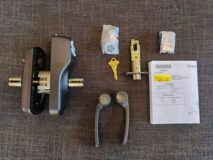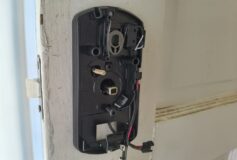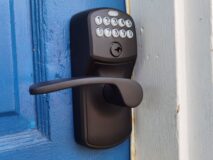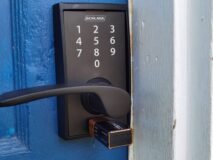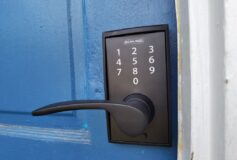
Gone are the days of fumbling for keys or worrying about lost or stolen keysets with the advent of smart locks. Keyless touchscreen door locks are a modern and convenient alternative to traditional door locks. But there are a lot of different smart locks available. Some connect to your Wi-Fi network, some don’t. Thus, as a homeowner, it can be confusing to know which one to get.
In this review, we’re looking at two smart locks from Schlage, the Touch Lever electronic lock, and the Keypad Lever electronic lock. Both offer pincode entry but the Keypad Lever can also be opened with a key. That offers an interesting proposition—key or no key?
Unboxing the Schlage electronic door locks
In most cases, people are replacing an existing door lock. Both lock kits come with everything you need to install it yourself. You’ll find the keypad unit, a latch, strike plate, back cover, and two levers. A 9-volt battery, installation manual, and all the required screws are also included. The Keypad lock comes with a single key. There are also additional parts—a pin wrench and an optional latch faceplate—included in the box.
Installing the Schlage electronic door locks
I installed both door locks on my front door for a comparison. It’s the best way for me to assess which one I prefer. I removed the existing lock and ensured the door dimensions were consistent with the instruction. The lock hole must be 2⅛” (53 mm) and the latch hole on the door edge must be 1” (25mm).
Next, I checked to see if the faceplate needed to be changed. Since my hole has no mortise, I did not need to change the faceplate. I began the installation by installing the latch. It’s important to make sure the latch angle faces the door jamb. Next, I installed the strike plate onto the door jam. The existing cutout was too low. I had to use my cordless multitool to cut out a section for the strike plate.
From there the installation was simple. I followed the instructions to install the keypad and connect the wire to the battery. Lastly, I installed the back covers and attached the levers according to the instructions. The final step is testing the lock.
Testing the Schlage electronic door locks
On the top left corner of the manual is a yellow/white sticker with the default codes for the lock. These are programming codes specific for each lock. It’s imperative that users don’t lose this information. By default, each lock comes with two user codes, but you can program additional pin codes. For the initial test, I used the User Code A pincode. I locked the door from the inside and went out to the front through my back door. I entered the code and rotated the lever. The lock opened for both locks. What I found interesting is that the lock automatically locks itself afterwards. For the Keypad lock, I also used the key to unlock the door. It worked just like any standard key lock.
Programming custom key codes
Both locks allow up to 19 different entry codes to be stored. Users can add and delete user codes at any time. The instructions provide the step-by-step procedures but you will need to enter the unique programming code provided on the instructions.
To add codes, I entered the programming code, pressed the Schlage button, and followed the instructions. The pin codes must be four numbers and different from the first four numbers of the programming code. In all, it was easy to add pin codes and then delete them afterwards.
Battery life
The big issue I have with the move to electronic door locks is the battery life. What happens if the battery dies? Will I be locked out? With the KeyPad lock, that’s not an issue. You can always get in with a key. Nevertheless, it says the battery should last about 3 years.
The Schlage Touch has a battery life of about two years. So what happens if the battery dies? Schlage has come up with a clever solution. Under the lever is two prongs where a 9-volt battery connects to. In an emergency situation, you can mount a battery to it and enter the pin code to get in. This alleviates my fear of pincode-only locks.
What I like about the Schlage electronic door locks
Keyless touchscreen door locks offer a lot convenience and ease of use. With these locks, you no longer need to carry around keys. You can program everyone in the family with their own custom pincode. If guests come to stay, program a pincode and share it with them. After they leave, it’s simple to delete it.
This is the exact reason I use an electronic door lock for my Airbnb suite. I can create temporary pin codes for guests and cleaners. Plus, I like that it doesn’t connect to my home Wi-Fi network. That’s one less problem to deal with. The only thing that could go wrong is a dead battery. Thankfully, both locks have options to deal with that. The Keypad Lock still work with a key, while the Touch Lever can support an external battery for temporary power.
Should you get a Schlage electronic lock?
Before upgrading to an electronic lock, first determine if this is even an option for you. Every door is different so take a good look at your existing lock. In my case, I replaced a deadbolt that went deep into the door frame. The Schlage latch didn’t go as deep as my deadbolt so I’m compromising some security for convenience.
Some door frames may not fit the Schlage strike plate, as it did in my case. Thankfully, I had a cordless multi-tool with wooden blades to make that cut. It added a lot of time to the install that I did not anticipate. My advice is to clear your schedule and have additional tools on hand just in case. Nevertheless, for the added convenience of an electronic door lock, it was worth it.
Final thoughts
Keyless touchscreen door locks offer a host of benefits, from enhanced security to convenience. Best of all, if you still want to use a key, some models like the Schlage Keypad Lock, allow you to do that. The only issue I see with electronic locks is the battery. Thankfully, both have solutions to alleviate of getting locked out. If you’re ready to make the switch to electronic locks, I highly recommend you check out the Schlage Touch Lever and Schlage Keypad Lever electronic locks.

